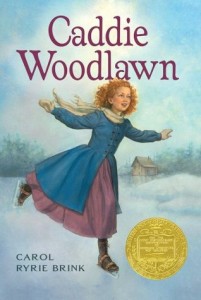 Brink, Carol Ryrie. Caddie Woodlawn
Brink, Carol Ryrie. Caddie Woodlawn
Original publication date: 1935
rpt. New York: Simon & Schuster, 2007
eISBN 978–1–4424–6858–0
Part of the charm of rereading, as an adult, books that I read as a child is understanding and appreciating how I must have reacted to the books back then. I didn’t remember much about Caddie Woodlawn when I put it on my Classics Club reading list except that I enjoyed it. Now I see why.
Carol Ryrie Brink based the book, and the character of Caddie, on her grandmother’s stories about her own childhood. The book opens in 1864 with a description of 11-year-old Caddie Woodlawn, “as wild a little tomboy as ever ran the woods of western Wisconsin.” Caddie and her sister Mary had both been frail and sickly when the family first came to Wisconsin from Boston seven years earlier. After Mary died, Mr. Woodlawn told his wife, “I want you to let Caddie run wild with the boys. Don’t keep her in the house learning to be a lady. I would rather see her learn to plow than make samplers, if she can get her health by doing so. I believe it is worth trying.” So Caddie was allowed to run free with her brothers, Tom and Warren, all over the area surrounding their farm.
Their adventures would have appealed to me because, as a young child, I also spent much of my time exploring the world around me in a small, rural New England town. I didn’t have siblings to accompany me, but some of my happiest memories are of sitting in the crotch of an apple tree below my house during apple blossom time and watching the bees buzz among the flowers. I also often tried to catch field mice in the unmown meadow with a coffee can, but I never succeeded. My parents had a troubled marriage, and I learned to take refuge outdoors.
Another feature of this book that would have appealed to me was the strong family life it portrays. I did not share that experience with Caddie’s family, and throughout my childhood I was drawn to books and television shows that offered alternate visions of what family life could be like.
Rereading the book now, I wonder how I reacted to the gender message that it carries. Although Caddie’s adventures appealed to me, I probably simply glossed over the gender issues. Children’s books entertain while at the same time imparting the message of what one’s society considers proper behavior, especially which behaviors are proper for boys and which for girls. Other members of society question Mr. Woodlawn’s approach to raising Caddie along with the boys. Early in the book the visiting circuit preacher asks, “When are you going to begin making a young lady out of this wild Indian, Mrs. Woodlawn?”
Significantly, Caddie turns 12 during the year of the book’s narrative, the traditional age of puberty that marks the progression into adulthood. After her birthday the gender message intensifies. Near the end of the book, Caddie’s mother punishes her for treating a visiting cousin badly, while the boys, who also participated, go free. Later Mr. Woodlawn “thrashes” the boys because he thinks it only fair that they share in the punishment, since he has raised Caddie, Tom, and Warren the same way.
Then father explains to Caddie:
It’s a strange thing, but somehow we expect more of girls than of boys. It is the sisters and wives and mothers, you know, Caddie, who keep the world sweet and beautiful. What a rough world it would be if there were only men and boys in it, doing things in their rough way! A woman’s task is to reach them gentleness and courtesy and love and kindness. It’s a big task, too, Caddie—harder than cutting trees or building mills or damming rivers. It takes nerve and courage and patience, but good women have those things. They have them just as ich as the men who build bridges and carve roads through the wilderness. A woman’s work is something fine and noble to grow up to, and it is just as important as a man’s. But no man could ever do it so well.”
You will not find a better description than this of the Victorian notion of separate spheres of life for men and women. This notion prescribed that business, finance, and politics were men’s world, while home and church constituted women’s world. There could be no overlap in these spheres of distinction. This concept also gave rise to the view of woman as a tender flower who had to be protected from the unsavory aspects of the world. This view conveniently kept women in their place and kept men in charge.
Like other young girls, I would have unconsciously and unquestioningly absorbed this vision of reality as truth. Caddie certainly does. After her father’s talk, she falls asleep.
When she awoke she knew that she need not be afraid of growing up. It was not just sewing and weaving and wearing stays. It was something more thrilling than that. It was a responsibility, but, as Father spoke of it, it was a beautiful and precious one, and Caddie was ready to go and meet it.
Thank you, Betty Friedan and Gloria Steinem, for shattering the notion of that view of life as a “thrilling responsibility, beautiful and precious,” that all girls should rush forward to meet as they grow up.

